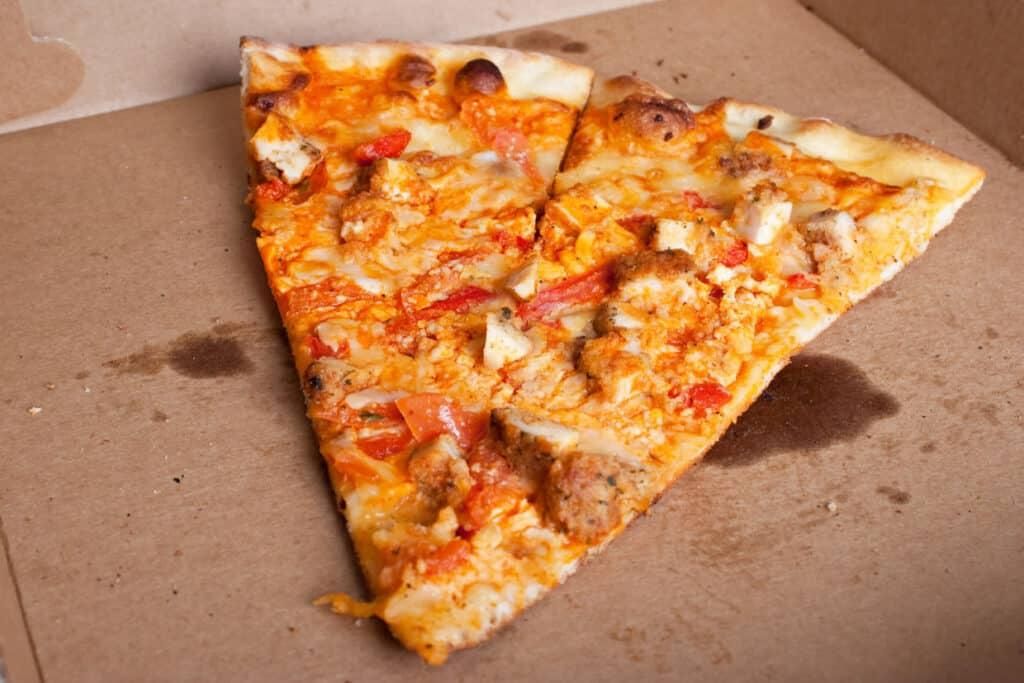
The best way to eat pizza is an ongoing debate.
In Pizza Hut’s second annual Pizza Trends Report, 57% of Americans prefer their leftover pizza cold, and science suggests there might be something to the claim. From the oxidation of food molecules to the role of starch, here’s what happens to leftover food in your fridge and how to make the most of it.
The secret about cold pizza
Pizza is at the center of many food arguments. Is New York-style or Chicago deep-dish better? Does pineapple belong on pizza? Is pizza better hot or cold?
The hot versus cold dispute is a heated one. When a Reddit user renewed the debate in 2023 by asserting that cold pizza is the better option, 160 users shared their opinions, ranging from “it depends on the pizza” to “absolute insanity.” More than half of the 5,000 people polled by Pizza Hut, though, agree they would rather eat their leftover pizza cold.
Scientists speculate on why this group prefers chilled pizza. Chilling foods mellows the flavors, particularly those that are bitter or sweet. Meanwhile, the taste receptors for saltiness are stronger in cold temperatures. This mutes the sweetness of the tomato sauce, causing the pizza to taste saltier. Other, more delicate flavors, such as the herbs in the sauce, can also come through stronger.
Oils in the pizza solidify when cold. This can lend the pizza extra stability and reduce the greasiness of a warm pizza. Those solidified oils also hold all of the flavors, absorbing and melding them as the pizza cools.
Why some leftovers taste better the next day
It’s not just pizza that benefits from a night in the fridge. Many dishes taste better the next day as flavors continue to develop. Meat dishes, such as stews, curries and spaghetti bolognese, contain collagen. This collagen starts breaking down when meat reaches 160 degrees Fahrenheit, absorbing other flavors in the dish. In the fridge, the collagen solidifies into a jelly, only to melt when reheated. This creates a silky texture packed with flavor in beef stew, ham and potato soup and other leftovers.
Fats from oils, meats, eggs and cream also absorb fat-soluble flavors like spices, balancing out a dish over time. On the other hand, oxidation, which is chemical changes caused by exposure to oxygen, can break down fats and form lipid byproducts that give reheated food an unpleasant flavor. This is why it is important to keep leftovers in airtight containers.
Baked goods can benefit from a few days of storage as well as the oils dispersing flavors. King Arthur shares the process of aging cakes by wrapping them tightly and leaving them at room temperature for a few days. For dense cakes like pound cakes or a chocolate beer cake, the extra days deepen flavors.
Make leftovers taste even better with reheating tips
Leftover pizza may be best served cold, but most other leftovers require reheating. If you’re using the microwave to reheat food, adjusting the power level is the secret to perfectly reheated food. A hundred percent power can dry out leftovers and cause uneven heating.
Instead, cook foods with high moisture content at 90% or 100% power. Foods like meats, pastas or others liable to get tough should be cooked at 50% to 60% power. Lower power means a longer cooking time, but yields a far more palatable result.
Adding extra moisture will also help keep reheated foods moist. Place a damp paper towel over your container or add a splash of water or milk. If you’re reheating something with a cream-based sauce, such as mac and cheese, add a bit more milk and stir repeatedly during cooking to prevent the sauce from separating.
If your reheated food is soggy, such as a slice of pizza, rewarm it in the oven or air fryer instead. This will restore crispy crusts, getting food as close as possible to a fresh texture.
How to reuse leftovers
To give extra life to dinners, repurpose leftovers into new dishes. Last night’s chicken and rice can become shredded chicken tacos for lunch the next day. Slice meats thinly for sandwiches or put extra vegetables into a casserole, stir fry, stew or quiche. Turn tomato sauce into a meatball pasta casserole.
If you don’t mind leftovers but want to break up the monotony of eating the same meal day after day, consider freezing them. Freezer bags or large silicone ice cube trays are great for freezing curries, soups and ingredients. Wrap pizza, burritos and biscuits in aluminum foil and store in a plastic bag.
Which foods to skip for leftovers
While many leftovers get better with age, some foods don’t hold up to storage and reheating. Others can actually be dangerous to eat as leftovers. Fried foods, such as French fries or chicken wings, often become soggy and can be tough when reheated. Shrimp may become rubbery, and the muscle fibers in steak will seize up, causing it to get tough. If you really want to save these foods, reheat them at a low temperature in the oven.
Fruits and vegetables may not last either. Zucchini and squash have high water content, and dishes that use them tend to get soggy as leftovers. Cut fruit and veggies will start to oxidize, giving them an unappealing appearance and texture. Likewise, salads with dressing will become limp and unappetizing.
Special care should be taken with eggs. In addition to becoming rubbery if you reheat them, the nitrogen in them will begin to oxidize if reheated too many times, and can make you sick.
Leftovers and food safety
Whichever foods you keep as leftovers, be sure to practice proper food safety techniques. Leftovers will last between three and five days in the fridge. You can also freeze leftovers for three to four months before the flavor starts to deteriorate. You also should not leave any prepared foods out for more than two hours to avoid bacterial growth.
If leftovers have an unusual smell, texture or taste, it’s best to discard them. Visible mold or discoloration is also a sign that food has gone off. When you’re unsure, it’s best to be safe and toss leftovers that might be bad.
Cold or hot, leftovers are the secret to a great meal
Leftovers are more than a convenient and cost-saving measure. Whether you’re enjoying a cold slice of pizza, transforming yesterday’s dinner into something new or aging a cake for better texture and taste, time can be a secret ingredient. Understanding the science behind how flavors evolve and how to handle food safely enables you to get more from every meal.
Jere Cassidy is the writer and recipe developer behind the blog One Hot Oven. A passion for all things food related led her to culinary school to expand her baking skills and now to share easy recipes for all home cooks and bakers of all skill levels. When not in the kitchen, Jere’ likes to travel far and wide to find delicious food.
Get more recipes and dinner ideas from The Washington Times food section.











